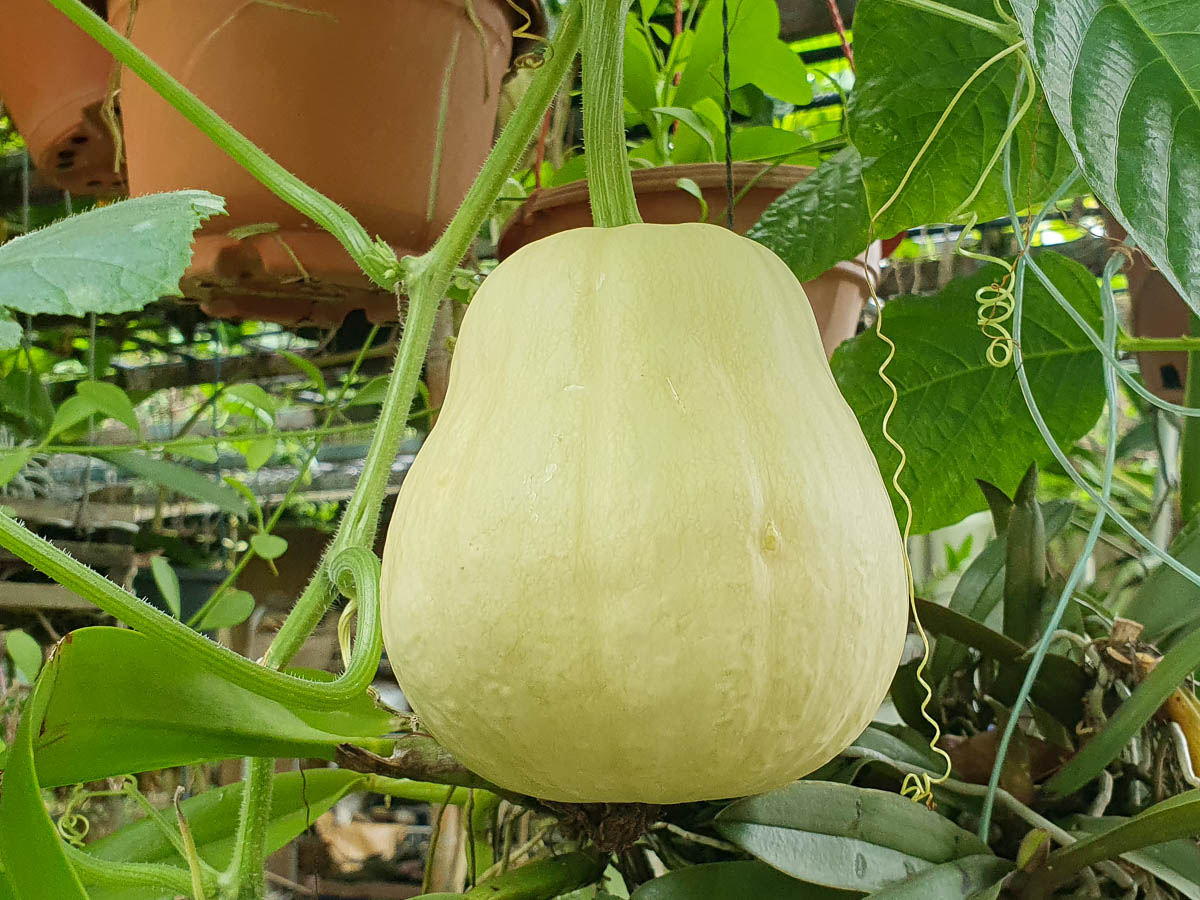Bottle Gourd
Bottle Gourd (Lagenaria siceraria)
Other common names: Labu Ayer Puteh, Calabash Gourd, 葫 芦

Bottle Gourds are an hourglass-shaped fruit that have edible flesh and seeds. Young fruit and seeds are fried, stewed, boiled, or steamed in a variety of Chinese and Indian dishes. Mature fruit have very hard skin, which can then be dried and processed into containers and musical instruments.
An annual crop, these plants are often grown in rotation with other fruiting climbers.
This plant is part of the Cucurbita or Melon family, which includes other popular edible fruits like Cucumber, Winter Melon, and Pumpkin.
Sun and soil needs:
This vine does best in full sun gardens with a minimum of 6 hours of sunlight. This plant can also grow in areas with at least 6 hours of indirect sunlight, but growth will be slower, and the vine will produce less fruit.
Plants do best in pots with loamy soil at least 30cm deep, or in true ground. The plant can be grown in smaller pots about 20cm deep, but growth will be slower and the plant will produce less fruits.
Sowing seeds:
Seeds can be sown directly into pots or the ground around 15-30cm apart. Lightly water the soil until damp, once a day. Seeds should sprout within 10 days.
The seedlings are generally resilient to most environmental factors but may be vulnerable to being eaten by snails or birds. Protect your young plants with a DIY cloche or netting.
Growing:
Bottle gourds will produce more flowers and thus more fruit when fed with fertilisers high in Phosphorus and Potassium. Plants can be fertilised regularly once a month after the first flower for a fuller crop.
Because the vines will grow on top of each other, it is a good practice to prune regularly and remove dead leaves and vines to improve ventilation and allow light to reach more of the plant.
As with all members of the melon family, this plant is bee pollinated and produces male and female flowers. To encourage the formation of more fruits, it is best to have at least 3 separate plants growing in the same area to have both male and female flowers available. Also, include bee-attracting plants within the garden to encourage pollination. If your garden lacks bees, the plant can also be hand pollinated.
Harvesting:
Plants can be harvested for immature, green fruits for eating around 2 months after sowing. The best time to harvest the fruit is in the early morning, before 9am. Fruits can be left on the vine to harden and mature if they are to be used for seeds or decorative purposes. The fruit will become hard and brown, with the supporting vine shrivelling when ripe.
The plant will continuously produce fruit for about 3 months to a year before declining.
Harvest cycle:
| Growing period | Sowing to germination | Germination to transplanting | Transplanting to first harvest | Total sowing to first harvest |
|---|---|---|---|---|
| Approximate time | less than a week | 2 to 3 weeks | 1 to 2 months | 2 to 3 months |
Check out our sowing and harvest planner to schedule your growing!
Propagation:
This vine can be grown via seeds. Seeds can be taken from mature fruit for immediate planting.
Common problems & solutions:
Young plants have soft stems and can be completely eaten by slugs and snails. Grow seedlings till they are at least 10cm tall before planting them in true ground, or use DIY cloches or netting to protect young plants.
If your plant has few to no flowers, you can fertilise the plant with fertilisers high in phosphorus and potassium. These nutrients encourage root and flower growth, which are important for the plant to produce more fruit.
However, if your plant is producing lots of flowers but is not bearing fruit, you may not have female and male flowers present in the same area together. Pollen from the male flower needs to be transferred to the female flower before the female flower can become a fruit. This process is called pollination and is important or the formation of many edible fruits. Vines from the melon family generally produce male flowers before female flowers. Having at least 3 plants of varying ages in the garden will make both male and female flowers present for pollination to happen.
Many plants require pollinators to help them fruit. Bees, butterflies, birds and even beetles transport pollen from one flower to another, pollinating your crops and increasing their fruit yield. Attract some pollinators to your garden by growing pollinator-attracting crops.
Aphids, Mealy Bugs, Whiteflies, and Spider Mites often infest the plant if it has underlying problems like repeated wilting from heat stress. Mechanical pest control methods like pruning the infested parts are the best methods for managing these pests in the short term, but resolving the underlying problem will prevent them in the long term.
Wilting leaves during hot weather is a sign of heat stress. Increase the number of times the plant is watered daily, and apply mulch at the base to prevent water loss.
Fruit flies, can lay eggs in the fruit, resulting in larvae damaging the fruit and creating spots on the skin. Wrap your fruit in netting when it starts to develop from a fertilised flower, ideally after all the petals have dropped off.
Squirrels and birds may eat unripe or ripe fruit. Wrap your fruit in netting when it starts to develop from a fertilised flower, ideally after all the petals have dropped off.

